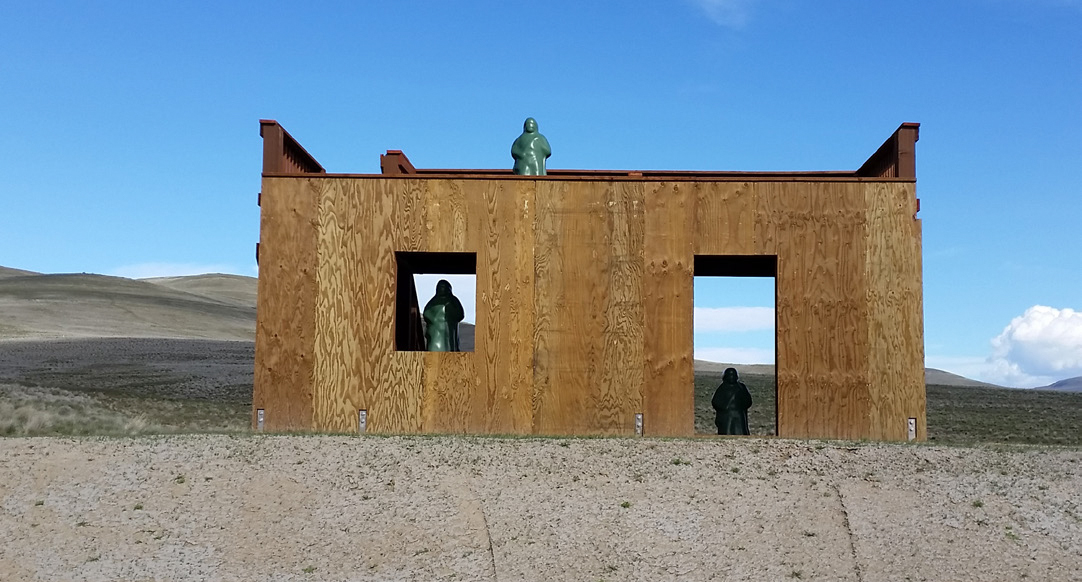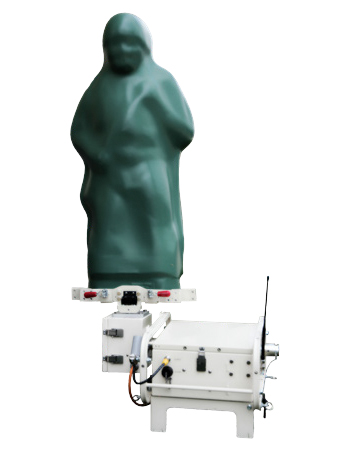Military
Quickconnect hardware allows the target head to be easily interchanged in various presentations, including pop-up target movement, swing out, slice, vertically rise and popup turning/judgmental target actions.
The MF-SIT has the unique ability to expose from multiple angles with a friend-or-foe target. Movements are precise, dynamic and respond quickly to commands of expose, conceal, slice and turn in any combination. In addition, the MF-SIT will rotate a regulation infantry target through 360 degrees at multiple angles. It can respond to hits; its automatic triggers are activated by soldier movements or a pre-programmed scenario. This ensures that trainees do not anticipate target actions, which provides a realistic environment for MOUT and specialized training.
The MF-SIT is also available with a double target arm to present multiple targets simultaneously. An embedded hit sensor in the MF-SIT target head responds to a range of munitions, with hit sensitivity remotely set from the range controller, consistent with the ammunition type being fired.
The MF-SIT can be operated via radio frequency, hardwire or Ethernet controls and can operate as a master target or slave target with up to 100 individual units assigned to a group. The target group can be commanded to respond in unison, so a hit on one target can cause all targets to fall or respond as otherwise commanded. Each target within a group also retains its own unique address and is capable of reacting to commands individually. No cabling is necessary to interconnect target mechanisms in the master/slave configuration. To enhance realism, the MF-SIT will initiate simulators such as muzzle flash, sound effects and MILES® Laser Target Interface (LTID) and can power and control thermal targets/heat pads.
Reliable and rugged, InVeris Training Solutions small arms targets perform in the harshest climates. They contain no hydraulic fluids, contaminants or hazardous toxins. With more than 33,000 infantry targets fielded, InVeris’ systems adapt to different range environments, infrastructures and operational constraints in supporting skills qualifications training and more complex collective training events.


| MF-SIT Lifting Unit Technical Specifications without battery | |
|---|---|
| PCB type | Plug & Play |
| Control | Ethernet, HW MUX, 2400 Baud RF (VHF/UHF), 900MHz RF, 2.4GHz RF |
| Power | 12VDC, 120VAC, 220-240VAC |
| Dimensions | 18” (457mm) L x 18” (457mm) W x 8.88” (225mm) H (with stacking cage) |
| Weight | 33.1lb (15kg) – (12V/RF configuration) |
| Lift speed | < 1.0 sec |
| Power switch | Standard orientation circuit breaker (North America). Inverted circuit breaker orientation (Europe/Asia) |
| Presentation modes | Single, Double and Triple Type 1 Pop-Up, Single Type 2 Pop-Up, Single Slice-Up, Single Swing-Out, Single Pop-Up Turning, Single Vertical Lift |
| Stackable | Yes |
| Thermal targets | Intensity control and status feedback with optional control module |
| MFS | Optional standard white, high output white and multi-color LED modules |
| Self-test | Standard Power On Self-Test Optional extended test functions using advanced handheld controller |
| Watertight | Yes, submersible IP67 |
| Wind | 37mph (60kph) Operation |
| Temperature | -35°F (-37°C) to +120°F (+49°C) Operation, -51°F (-46°C) to +175°F (+80°C) Storage |
| Expose angle | Adjustable in 22.5° increments |
| Mounting | Quick-release Spring pins or mounting screws |
| Pop-Up Turning Product Specifications | |
|---|---|
| Dimensions-exposed | 18” (457mm) L x 29.25” (743mm) W x 12.5” (318mm) H (requires 6” of elevation for floor mounting) |
| Dimensions-concealed | 21.5” (546mm) L x 18” (457mm) W x 9.5” (241mm) H (requires 6” of elevation for floor mounting) |
| Weight | 48.5lb (22kg) |
| Turn speed | 0.3 sec |
| Turn angle | Adjustable in 15° increments |
| Adjustable height | None |
| Target types | Accommodates 3D “Fat Ivan” and clothed Figure 11 UK target |
| Target thickness | 0-0.6” (15mm) |
| Stackable | Yes, in exposed, edge position |
| LOMAH compatible | Yes |
| Slice-Up Product Specifications | |
|---|---|
| Dimensions-exposed | 19.38” (493mm) L x 20.25” (515mm) W x 12.75” (324mm) H |
| Dimensions-concealed | 21.75” (553mm) L x 20.25” (515mm) W x 19.38” (493mm) H |
| Weight | 37.5lb (17kg) |
| Adjustable height | Optional 0-4” (100mm) |
| Target types | Accommodates 3D “Fat Ivan” and clothed Figure 11 UK target |
| Target thickness | 0-0.6” (15mm) |
| Stackable | Yes, in exposed or concealed position with units indexed 180° to each other |
| LOMAH compatible | Yes |
| Vertical Lift, 20” Product Specifications | |
|---|---|
| Dimensions-exposed | 21.75” (553mm) L x 18.25” (464mm) W x 33.25” (845mm) H |
| Dimensions-concealed | 30.5″ (775mm) L x 18.25” (464mm) W x 13.25” (336mm) H |
| Weight | 45.2lb (20.5kg) |
| Adjustable height | None |
| Target types | Accommodates 3D “Fat Ivan” and clothed Figure 11 UK target |
| Target thickness | 0-0.6” (15mm) |
| Stackable | No |
| LOMAH compatible | Yes |
| Pop-Up, Standard Technical Specifications | |
|---|---|
| Dimensions-exposed | 18” (457mm) L x 18” (457mm) W x 12.2” (310mm) H |
| Dimensions-concealed | 20.75” (527mm) L x 18” (457mm) W x 11.25” (286mm) H |
| Weight | 37.5lb (17kg) |
| Target types | Accommodates 3D “Fat Ivan” and clothed Figure 11 UK target |
| Target thickness | 0-0.6” (15mm) |
| Stackable | Yes, in concealed position |
| LOMAH compatible | Yes |
| Options | Unit can also be wall-mounted to act as a Swing-Out with a side mount flat target |
| Pop-Up, Type 2 Technical Specifications | |
|---|---|
| Dimensions-exposed | 26.25” (667mm) L x 18” (457mm) W x 8.88” (225mm) H |
| Dimensions-concealed | 18” (457mm) L x 18” (457mm) W x 17” (432mm) H |
| Weight | 37.5lb (17kg) |
| Adjustable height | Optional 0-4” (100mm) |
| Target types | Accommodates 3D “Fat Ivan” and clothed Figure 11 UK target |
| Target thickness | 0-0.6” (15mm) |
| Stackable | Yes, in exposed position |
| LOMAH compatible | Yes |
| Pop-Up, Double Target Technical Specifications | |
|---|---|
| Dimensions-exposed | 18” (457mm) L x 37.25” (947mm) W x 12.2” (310mm) H |
| Dimensions-concealed | 20.75” (527mm) L x 37.25” (947mm) W x 11.25” (286mm) H |
| Weight | 42.5lb (19.3kg) |
| Adjustable height | Optional 0-4” (100mm) |
| Target types | Accommodates 3D “Fat Ivan” and clothed Figure 11 UK target |
| Target thickness | 0-0.6” (15mm) |
| Stackable | Yes, in concealed position |
| LOMAH compatible | Yes |
| Swing-Out, Bottom Target Mount Technical Specifications | |
|---|---|
| Dimensions-exposed | 42.25” (1074mm) L x 9.25” (235mm) W x 18.5” (470mm) H (wall mounted dimensions, at 15.5” target placement) |
| Dimensions-concealed | 18” (457mm) L x 33.5” (851mm) W x 18.5” (470mm) H (wall mounted dimensions, at 15.5” target placement) |
| Weight | 37.5lb (17kg) |
| Adjustable height | N/A, must be wall mounted |
| Target types | Accommodates 3D “Fat Ivan” and clothed Figure 11 UK target |
| Target thickness | 0-0.6” (15mm) |
| Target placement | Adjustable from 12.5” (317mm) to 15.5” (394mm) (edge of stacking cage to centerline of target) |
| Stackable | Yes, in exposed position |
| LOMAH compatible | Yes |